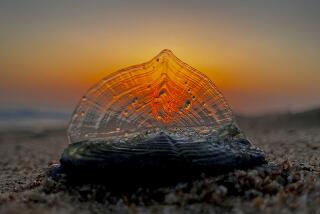By-the-wind sailor
[VELELLA VELELLA]
One of the great joys of walking along ocean beaches is running across treasures washed up from afar. After the first strong southerly or westerly winds of the year -- anytime from late winter into spring -- Pacific beaches may become blanketed with small blue creatures blown in from the open ocean. Each one is a complex polyp, closely related to jellyfish, complete with feeding organs, tentacles for stinging prey and reproductive structures all positioned beneath a floating platform and a diminutive sail, formed of a cellophane-like tissue. By-the-wind sailors, as they are popularly known, normally drift on the ocean surface but are caught helplessly in powerful storms and cast onto beaches by the millions. Within days, their deep blue color fades into clear parchment and they blow about the beach like transparent leaves.
NATURAL HISTORY
In addition to feeding on tiny passive prey, such as crustacean larvae, by-the-wind sailors also contain single-celled algae that photosynthesize in the sunlight and contribute nutrients in a
symbiotic relationship.
KEY CHARACTERISTICS
Two inches long with an elliptical floating platform that contains air-filled concentric rings
providing added buoyancy.
More to Read
Sign up for The Wild
We’ll help you find the best places to hike, bike and run, as well as the perfect silent spots for meditation and yoga.
You may occasionally receive promotional content from the Los Angeles Times.





